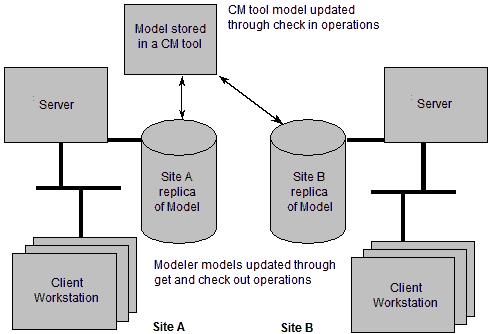Local Editing of Models that are Stored in an Integrated CM tool
This solution provides the most controlled solution for working across sites. The Modeler model is stored in a CM tool. If a site wants to work with the model, they create a replica of the model in their Modeler environment.
Each site checks out Packages they want to change. While a Package is checked out, other sites cannot change that Package. After making the required changes, the site checks in their Packages. To use the CM tool integration, you require a live connection between the sites, a Modeler license and a CM Integration license.
For more information about configuration management tool integration, see the Modeler User's Guide.
The following diagram illustrates a potential configuration for working across sites in this way.

The following table summarizes the advantages and disadvantages of working with replicas of CM tool models:
Advantages | Disadvantages |
|---|---|
CM tool change control ensures that only one site makes changes to a Package at any given time. However, this could be seen as a disadvantage as well. | • CM tool change control ensures that only one site makes changes to a Package at any given time. However, this could be seen as a disadvantage as well. • Using an external CM tool with a model disables the database-based configuration management features of Modeler for that model. • This solution does not support parallel development of a model. • Other users see your changes only after you have checked in the associated Packages, and the other users have then updated their models through Get or Check Out operations on those Packages. |
The following table outlines the steps for setting up the sites:
Step | Consideration |
|---|---|
1. Perform a Server Only installation on each project site. | A server will be required for each site. |
2. Install the CM tool server software on one site, and the CM tool client software on both sites. | Decide which site is going to be responsible for the CM tool server, including backups. |
3. Determine the split of work between the sites and set up the Package hierarchy and Package access permissions accordingly. | • Within a model, use Packages to group items assigned to each site. • The access permissions of the Packages should re-enforce the work ownership. For example, for Packages owned by site A, site A team members should have write access and site B team members should have read-only access. Alternatively, the Protected property of Packages could be set to control access on each site. |